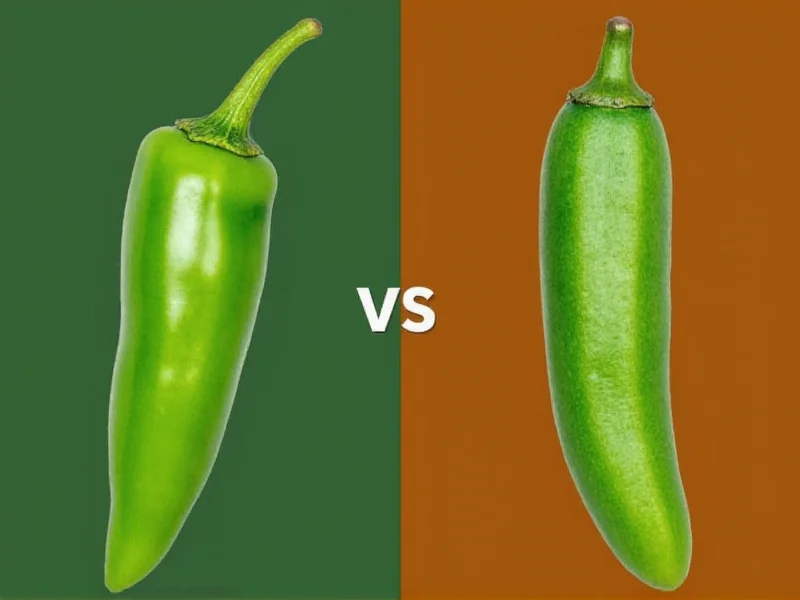Understanding the differences between jalapeño and serrano peppers is essential for home cooks and culinary enthusiasts seeking to perfect their dishes. While both belong to the Capsicum annuum species and share visual similarities, their distinct heat levels, flavor profiles, and culinary applications make them unique ingredients in Mexican and global cuisines.
Physical Characteristics Compared
At first glance, these peppers can be confusingly similar, but closer inspection reveals clear differences. Jalapeños typically grow 2-4 inches long with a smooth, thick-walled structure that transitions from bright green to deep red as they mature. Their shape is generally stout with rounded shoulders tapering to a blunt end.
Serranos, meanwhile, are noticeably smaller (1-2.5 inches) with thinner walls and a more elongated, tapered shape resembling a small banana pepper. They maintain a consistently bright green color when immature, turning yellow, orange, or red when fully ripe. The thinner walls of serranos make them less suitable for stuffing but perfect for blending into sauces.
| Characteristic | Jalapeño | Serrano |
|---|---|---|
| Size | 2-4 inches long | 1-2.5 inches long |
| Wall Thickness | Thick (ideal for stuffing) | Thin (better for blending) |
| Color Range | Green to red | Green, yellow, orange, red |
| Shape | Stout with rounded shoulders | Elongated, tapered |
Heat Level and Scoville Scale Comparison
The most significant difference between these peppers lies in their heat intensity. Jalapeños vs serranos heat comparison reveals serranos consistently run 2-3 times hotter. Jalapeños measure 2,500-8,000 Scoville Heat Units (SHU), placing them in the medium heat category. Serranos, however, range from 10,000-23,000 SHU, firmly in the hot category.
This heat difference becomes particularly important when substituting serrano for jalapeño in recipes. Using equal amounts will result in significantly spicier dishes. A general rule: one serrano pepper equals approximately 1.5-2 jalapeños in heat intensity. The heat distribution also differs—serranos deliver a quicker, sharper burn concentrated in the front of the mouth, while jalapeños provide a more gradual, earthy warmth that builds slowly.
Flavor Profiles and Culinary Applications
Beyond heat, these peppers offer distinct flavor experiences. Jalapeño and serrano flavor differences are subtle but significant to discerning palates. Jalapeños present a grassy, slightly sweet profile with earthy undertones, especially when roasted. Their thicker walls contain more capsaicin-storing placenta, contributing to their characteristic warmth.
Serranos deliver a brighter, fruitier flavor with citrus notes and less earthiness. Their thinner walls mean less vegetable matter and more concentrated heat. This makes serranos ideal for fresh applications like pico de gallo, where their clean heat shines without overwhelming other ingredients.
When using serrano peppers instead of jalapeños, consider the dish's texture requirements. The thicker walls of jalapeños hold up better to cooking methods like grilling, stuffing, and pickling. Serranos' thinner structure breaks down more readily, making them perfect for blended salsas, hot sauces, and dishes where you want the pepper to integrate completely.
Practical Substitution Guide
Understanding when to use each pepper can transform your cooking. For comparing jalapeño and serrano in recipes, follow these guidelines:
- Choose jalapeños when: Making stuffed peppers, jalapeño poppers, pickled jalapeños, or any dish requiring structural integrity during cooking
- Choose serranos when: Creating fresh salsas, hot sauces, or dishes where immediate, clean heat is desired without overwhelming texture
- Substitution ratio: Replace one jalapeño with half a serrano for similar heat levels, adjusting to taste
- Heat control tip: Remove seeds and membranes from either pepper to reduce heat significantly while maintaining flavor
Growing Considerations and Availability
Gardeners should note that serrano plants typically grow taller (up to 4 feet) with more compact fruit clusters compared to jalapeño plants. Serranos mature slightly faster but produce fewer peppers per plant. Both thrive in similar conditions with full sun and well-draining soil.
In terms of availability, jalapeños dominate mainstream grocery stores due to their versatility and milder heat. Serranos appear more frequently in Latin American markets and specialty grocers. During peak season (summer through early fall), both are widely available, but serranos may be harder to find outside Mexican culinary hubs.
Nutritional Comparison
Both peppers offer impressive nutritional profiles with minimal calories. A single raw jalapeño (14g) contains approximately 4 calories, 0.1g protein, and 0.7g carbohydrates, while providing 12% of your daily vitamin C needs. Serranos (9g) offer similar nutrition with about 3 calories, 0.1g protein, and 0.7g carbohydrates per pepper, plus 10% of daily vitamin C.
The capsaicin responsible for their heat provides anti-inflammatory benefits and may boost metabolism. Serranos' higher capsaicin content means slightly greater potential health benefits per gram, though both contribute valuable nutrients to a balanced diet.
Storage and Handling Tips
Proper storage extends freshness: keep both peppers in the crisper drawer of your refrigerator for 1-2 weeks. For longer storage, freeze whole peppers in airtight containers for up to 6 months—frozen serranos blend beautifully into cooked sauces.
When handling either pepper, especially serranos, wear gloves to prevent capsaicin burns. Always wash hands thoroughly after handling and avoid touching your face. If you experience burning, dairy products like milk or yogurt provide immediate relief by binding to capsaicin molecules.
Final Recommendations
Understanding which is hotter jalapeño or serrano is just the beginning. The choice between these peppers should consider your specific culinary application, desired heat progression, and texture requirements. For beginner cooks, jalapeños offer more forgiving versatility, while experienced chefs often reach for serranos when precise, intense heat is needed.
Remember that growing conditions significantly affect heat levels—peppers grown in stress conditions (less water, more sun) develop higher capsaicin concentrations. Always taste a small piece before committing to a recipe, as individual peppers can vary dramatically in heat intensity regardless of type.











 浙公网安备
33010002000092号
浙公网安备
33010002000092号 浙B2-20120091-4
浙B2-20120091-4